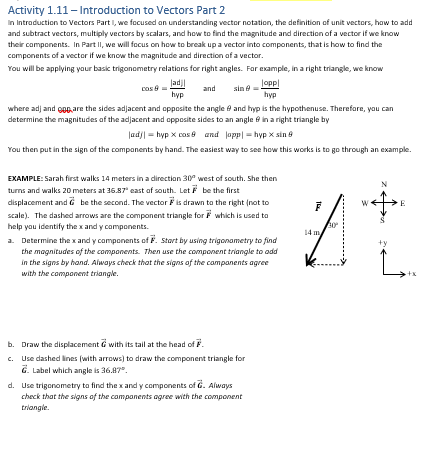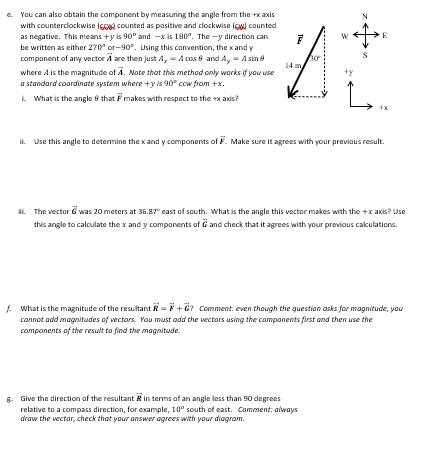Activity 1.11 - Introduction to Vectors Part 2 In Introduction to Vectors Part 1, we focused on understanding vector notation, the definition of unit vectors, how to add and subtract vectors, multiply vectors by scalars, and how to find the magnitude and direction of a vector if we know their components. In Part II, we will focus on how to break up a vector into components, that is how to find the components of a vector if we know the magnitude and direction of a vector. You will be applying your basic trigonometry relations for right angles. For example, in a right triangle, we know Jadj| and sin hyp where adj and are the sides adjacent and opposite the angle and hyp is the hypothenuse. Therefore, you can determine the magnitudes of the adjacent and opposite sides to an angle in a right triangle by |ad)| = hyp X cas 8 and app|hypx sin 8 You then put in the sign of the components by hand. The easiest way to see how this works is to go through an example. cos loppl hyp EXAMPLE: Sarah first walks 14 meters in a direction 30° west of south. She then turns and walks 20 meters at 36.87" east of south. Let F be the first displacement and be the second. The vector is drawn to the right (not to scale). The dashed arrows are the component triangle for which is used to help you identify the x and y components. a. Determine the x and y components of F. Start by using trigonometry to find the magnitudes of the components. Then use the component triangle to add in the signs by hand. Always check that the signs of the components agree with the component triangle. b. Draw the displacement with its tail at the head of F. c. Use dashed lines (with arrows) to draw the component triangle for 7. Label which angle is 36.87". F 14 m 40 E LIK +x
Activity 1.11 - Introduction to Vectors Part 2 In Introduction to Vectors Part 1, we focused on understanding vector notation, the definition of unit vectors, how to add and subtract vectors, multiply vectors by scalars, and how to find the magnitude and direction of a vector if we know their components. In Part II, we will focus on how to break up a vector into components, that is how to find the components of a vector if we know the magnitude and direction of a vector. You will be applying your basic trigonometry relations for right angles. For example, in a right triangle, we know Jadj| and sin hyp where adj and are the sides adjacent and opposite the angle and hyp is the hypothenuse. Therefore, you can determine the magnitudes of the adjacent and opposite sides to an angle in a right triangle by |ad)| = hyp X cas 8 and app|hypx sin 8 You then put in the sign of the components by hand. The easiest way to see how this works is to go through an example. cos loppl hyp EXAMPLE: Sarah first walks 14 meters in a direction 30° west of south. She then turns and walks 20 meters at 36.87" east of south. Let F be the first displacement and be the second. The vector is drawn to the right (not to scale). The dashed arrows are the component triangle for which is used to help you identify the x and y components. a. Determine the x and y components of F. Start by using trigonometry to find the magnitudes of the components. Then use the component triangle to add in the signs by hand. Always check that the signs of the components agree with the component triangle. b. Draw the displacement with its tail at the head of F. c. Use dashed lines (with arrows) to draw the component triangle for 7. Label which angle is 36.87". F 14 m 40 E LIK +x
Principles of Physics: A Calculus-Based Text
5th Edition
ISBN:9781133104261
Author:Raymond A. Serway, John W. Jewett
Publisher:Raymond A. Serway, John W. Jewett
Chapter1: Introduction And Vectors
Section: Chapter Questions
Problem 43P
Related questions
Question

Transcribed Image Text:Activity 1.11 - Introduction to Vectors Part 2
In Introduction to Vectors Part 1, we focused on understanding vector notation, the definition of unit vectors, how to add
and subtract vectors, multiply vectors by scalars, and how to find the magnitude and direction of a vector if we know
their components. In Part II, we will focus on how to break up a vector into components, that is how to find the
components of a vector if we know the magnitude and direction of a vector.
You will be applying your basic trigonometry relations for right angles. For example, in a right triangle, we know
and
Jadj|
hyp
where adj and are the sides adjacent and opposite the angle and hyp is the hypothenuse. Therefore, you can
determine the magnitudes of the adjacent and opposite sides to an angle in a right triangle by
|ad)| hyp X cos and app|=hyp X sin 8
You then put in the sign of the components by hand. The easiest way to see how this works is to go through an example.
cos=
sin
loppl
hyp
EXAMPLE: Sarah first walks 14 meters in a direction 30° west of south. She then
turns and walks 20 meters at 36.87° east of south. Let F be the first
displacement and be the second. The vector is drawn to the right (not to
scale). The dashed arrows are the component triangle for which is used to
help you identify the x and y components.
a. Determine the x and y components of F. Start by using trigonometry to find
the magnitudes of the components. Then use the component triangle to add
in the signs by hand. Always check that the signs of the components agree
with the component triangle.
b. Draw the displacement with its tail at the head of F.
c. Use dashed lines (with arrows) to draw the component triangle for
G. Label which angle is 36.87".
d. Use trigonometry to find the x and y components of G. Always
check that the signs of the components agree with the component
triangle.
F
+y
L
+x

Transcribed Image Text:e. You can also obtain the component by measuring the angle from the +x axis
with counterclockwise (60) counted as positive and clockwise (6) counted
as negative. This means +y is 90° and -x is 180°. The-y direction can
be written as either 270 or-90°. Using this convention, the x and y
component of any vector A are then just A₂ = A cos 8 and A, - A sin 8
where A is the magnitude of A. Note that this method only works if you use
a standard coordinate system where +y is 90° ccw from +x.
What is the angle 8 that
makes with respect to the +x axis?
F
30
N
L
g. Give the direction of the resultant in terms of an angle less than 90 degrees
relative to a compass direction, for example, 10° south of east. Comment: always
draw the vector, check that your answer agrees with your diagram.
E
+x
II. Use this angle to determine the x and y components of F. Make sure it agrees with your previous result.
The vector was 20 meters at 36.87° east of south. What is the angle this vector makes with the +x axis? Use
this angle to calculate the x and y components of G and check that it agrees with your previous calculations.
f. What is the magnitude of the resultant R=F+G? Comment: even though the question asks for magnitude, you
cannot add magnitudes of vectors. You must add the vectors using the components first and then use the
components of the result to find the magnitude.
Expert Solution
This question has been solved!
Explore an expertly crafted, step-by-step solution for a thorough understanding of key concepts.
This is a popular solution!
Trending now
This is a popular solution!
Step by step
Solved in 4 steps with 2 images

Knowledge Booster
Learn more about
Need a deep-dive on the concept behind this application? Look no further. Learn more about this topic, physics and related others by exploring similar questions and additional content below.Recommended textbooks for you

Principles of Physics: A Calculus-Based Text
Physics
ISBN:
9781133104261
Author:
Raymond A. Serway, John W. Jewett
Publisher:
Cengage Learning

Physics for Scientists and Engineers: Foundations…
Physics
ISBN:
9781133939146
Author:
Katz, Debora M.
Publisher:
Cengage Learning

Principles of Physics: A Calculus-Based Text
Physics
ISBN:
9781133104261
Author:
Raymond A. Serway, John W. Jewett
Publisher:
Cengage Learning

Physics for Scientists and Engineers: Foundations…
Physics
ISBN:
9781133939146
Author:
Katz, Debora M.
Publisher:
Cengage Learning